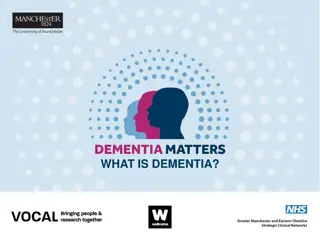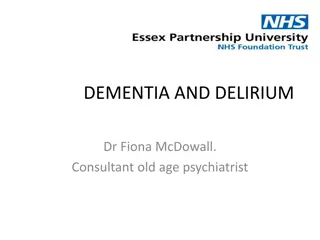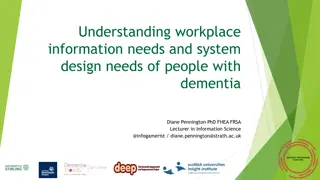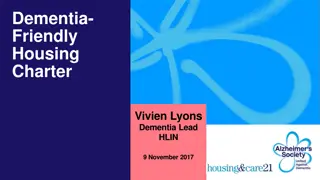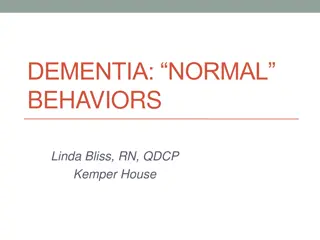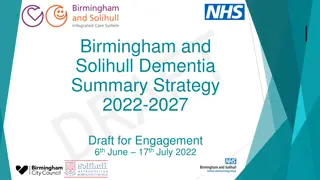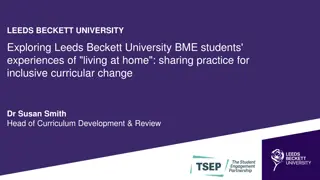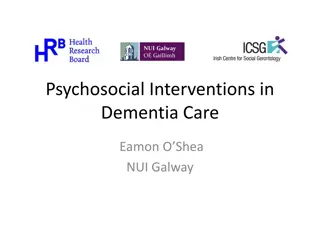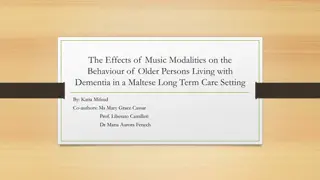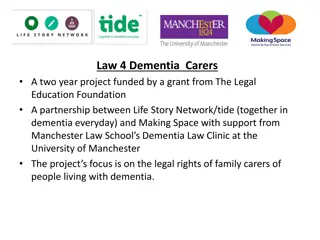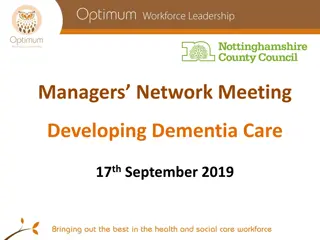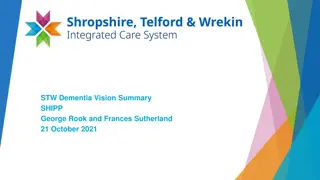Understanding the Intersection of Dementia, BME Communities, and Direct Payments in Scotland
This project explores the effectiveness and cultural sensitivity of Direct Payments in meeting the challenges faced by BME individuals with dementia. Through research, it aims to amplify the voices of participants, inform policy-making, and advance scholarly debates on personalized support for BME dementia patients in Scotland.
Download Presentation

Please find below an Image/Link to download the presentation.
The content on the website is provided AS IS for your information and personal use only. It may not be sold, licensed, or shared on other websites without obtaining consent from the author. Download presentation by click this link. If you encounter any issues during the download, it is possible that the publisher has removed the file from their server.
E N D
Presentation Transcript
BACKGROUND DEMENTIA- Working in care homes and nursing homes in London I noticed needs of people with dementia were not always met due to lack of awareness, information and staff training. DIRECT PAYMENT AND BLACK AND MINIROTY ETHNIC (BME) PEOPLE Social worker in community care team for 7 years. Two years in Funding Independent Team that specialised in offering advice on direct payments to various practitioners. It was while working in this team I realised the challenges that people with dementia from BME communities were experiencing when they were trying to find suitable services. OTHERS: Role with Scottish Social Services Council as dementia ambassador. Dementia friendly community. Being a BME person I have always been interested in the needs of BME people especially after learning about the gaps through my previous work, different forums, conferences and events I have attended.
AIMS AND OBJECTIVES This project aims to explore if DP is an effective and culturally sensitive response to meeting the specific challenges currently faced by BME people with dementia. It is intended that the research findings will contribute to informing policy makers and practice in planning and delivery of DP to BME people. Within this, specific aims are: Giving the participants a space to express their voice in order to provide valuable insights into how they experience, receive and perceive personalised support. To contribute to new knowledge and move forward the current scholarly debates around the future for DP in relation to meeting the needs of BME people with dementia in Scotland which is underexplored area.
1. BME people with dementia who are in receipt of Direct Payments? What are the experiences of 2 Direct Payments to provide personalised services for BME people with dementia? What is the potential for S a) BME people with dementia experience when accessing Direct Payments? What are the challenges that b) Direct Payments for BME people with dementia? What are the benefits of 3 carers and stakeholders who support BME people with dementia in receipt of Direct Payments? What are the experiences of
INTERSECTION OF DEMENTIA, BLACK AND MINORITY ETHNIC (BME) AND DIRECT PAYMENTS (DP) The person with dementia s needs Dementia BME PEOPLE DIRECT PAYMENTS
BIO-PSYCHOSOCIAL MODEL Biological factors Genetics predisposition, physiological response to illness, immune response Socialogical factors Psychological factors. Social networks, families, community, community support, services available. Stress, coping mechanisms, personality, health related habits, reaction to diagnosis. A Person with dementia Engel, 1977
PERSON CENTRED APPROACH (Kitwood, 1997) Communication Activities Social Person Environment NB: Promotes autonomy, independence, reliability, flexibility and puts the person at the centre of their care Health
CITIZENSHIP LENS Citizenship highlights that people s experiences are shaped by social-cultural practices and societal assumptions allowing more scope for inclusion and understanding of people with dementia. Citizenship also focuses on empowering people with dementia, upholding their rights, agency and their social and personal relationships. Citizenship recognises that people with dementia have rights, a history and are competent individuals who can still actively participate in a meaningful way in their life even after diagnosis. (Birt et al., 2017; O'Connor, 2016; Bartlett and O Connor, 2007; 2010; Kelly and Innes, 2013).
METHODOLOGY A qualitative research method will be used, adopting a constructivist narrative approach. It is deemed appropriate for gathering stories from the participants about aspects of their lives that is linked to the study objectives and what matters to them. Experiences and reality are socially, historically, culturally and situational constructed and how we act, perceive our environment, our world, our social relationships and perceive different events in our lives are guided by this knowledge. Therefore, constructivist narrative approaches will enable us to understand how meaning is constructed and co-created through stories of lived experiences of the participants. The data will then be analysed using narrative and thematic approaches to gain insights and understanding of the individual s experiences.
ETHICAL CONSIDERATION Consent is a major consideration and Dewing (2007) process consent will be utilised. This method will encourage me to revisit and re-assess informed consent throughout the fieldwork. Power imbalances between researcher and participants will be explored and addressed through being respectful, good communication, preparation and debriefing. I am currently in the process of applying for Ethical Approval from the General University Ethics Panel (GUEP). Then I will start contacting gate keepers and thereafter start the field work.
REFERENCES Bartlett, R., and O'Connor, D. (2007). From personhood to citizenship: Broadening the lens for dementia practice and research. Journal of Aging Studies, Vol. 21, pp. 107 118. Bartlett, R., and O'Connor, D. (2010). Broadening the dementia debate: Toward social citizenship. London: Policy Press. Birt. L., Poland, F., Csipke, E., and Charlesworth, G. (2017) Shifting dementia discourses from deficit to active citizenship. Sociology of Health & Illness, vol. 39(2), pp. 199 211. Creswell, J.W (2003) Research Design: Qualitative, Quantitative and Mixed Methods Approaches (2nd eds), Sage: London. Dewing J. (2007) Participatory research: a method for process consent with persons who have dementia. Dementia, vol. 6, pp. 11 25. Engel, G. L. (1977) The need for a new medical model: a challenge for biomedicine. Science, vol. 196, pp. 129 136. Kelly, F. and Innes, A. (2013) Human rights and citizenship in dementia care nursing, International Journal of Older People Nursing, vol. 8 (1), pp. 61 70. Kitwood, T. (1997) The experience of dementia, Aging and Mental Health, vol. 1 (1), pp. 13-22. O Connor, D (2016) Editorial introduction: Special issue on Citizenship and Dementia, Dementia 2016, vol. 15(3) pp. 285 288. Polkinghorne, D. E. (1988) Narrative Knowing and the Human Sciences. Albany: University of New York Press. Prawat, R. S., & Floden, R. E. (1994). Philosophical Perspectives on Constructivist Views of Learning. Educational Psychologist, vol.29(1), pp. 37-48. Sabat, S. R. (2001) The Experience of Alzheimer's Disease: Life Through a Tangled Veil. Wiley-Blackwell, New Jersey. Sabat, S. R. (2008) A bio-psycho-social approach to dementia, Available at: https://www.researchgate.net/publication/283413651_A_bio-psycho-social_approach_to_dementia, [Accessed, 22/08/19].
ANY ANY QUESTIONS? QUESTIONS?


